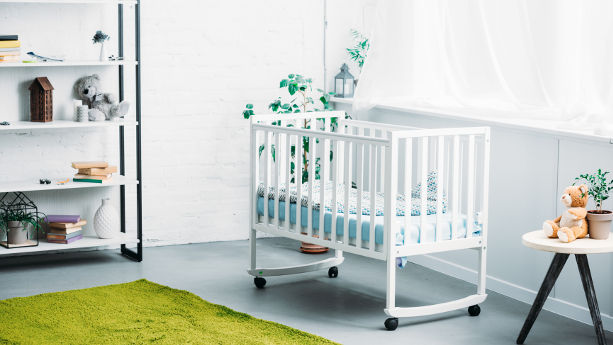
Children’s furniture sold in the United States must comply with strict safety standards, in addition to labelling, certification, and testing requirements. In this guide, we explain how the CPSIA, 16 CFR Part 1640, the Lacey Act, California Proposition 65 and other compliance requirements relate to children’s furniture.
Content Overview

FREE CONSULTATION CALL (US, EU & UK)
- Request a free 30-minute call with Ivan Malloci to learn how we can help you with:
- Find product requirements
- Certification and labeling
- Lab testing
Consumer Product Safety Improvement Act (CPSIA)
The Consumer Product Safety Improvement Act contains requirements affecting children’s products. This also includes children’s furniture, for which there are several CPSC standards.
In general, the CPSIA sets the following requirements:
- Compliance with relevant standards
- Children’s Product Certificate
- Tracking label
Additionally, many furniture products are considered durable infant products, for which additional requirements apply. Here are some examples:
- Children’s folding chairs
- Children’s stools
- Toddler beds
- Cribs
Standards
Several CPSC regulations contain standards covering children’s furniture products, some of which incorporate ASTM standards by reference. Below we list examples of CPSC standards and the respective incorporated ASTM standards.
| CPSC standard | Incorporated ASTM standard |
| 16 CFR Part 1217 – Safety Standard for Toddler Beds | ASTM F1821 – Standard Consumer Safety Specification for Toddler Beds |
| 16 CFR Part 1219 – Safety Standard for Full-Size Baby Cribs | ASTM F1169 – Standard Consumer Safety Specification for Full-Size Baby Cribs |
| 16 CFR Part 1220 – Safety Standard for Non-Full-Size Baby Cribs | ASTM F406 – Standard Consumer Safety Specification for Non-Full-Size Baby Cribs/Play Yards |
| 16 CFR part 1232 – Safety Standard For Children’s Folding Chairs and Children’s Folding Stools | ASTM F2613 – Standard Consumer Safety Specification for Children’s Chairs and Stools |
| 16 CFR Part 1261 – Safety Standard for Clothing Storage Units | ASTM F2057 – Standard Safety Specification for Clothing Storage Units |
| 16 CFR Part 1231 – Safety Standard for High Chairs | ASTM F404 – Standard Consumer Safety Specification for High Chairs |
| 16 CFR Part 1237 – Safety Standard for Booster Seats | ASTM F2640 – Standard Consumer Safety Specification for Booster Seats |
| 16 CFR Part 1513 – Requirements for Bunk Beds | None |
Note that other standards and requirements (e.g. small parts) may also be relevant to your product.
Substance restrictions
The CPSIA sets substance restrictions for children’s products, including children’s furniture products.
For example, the lead content limit contained in section 101 of the Act prohibits children’s products from containing lead exceeding 100 ppm. The lead-containing paint limit is found in 16 CFR Part 1303. Under this part, children’s products must not be painted with paint that contains more than 0.009% of lead.
16 CFR Part 1307 sets restrictions for phthalates. Specifically, plasticized components or any other component part that may contain phthalates in children’s toys and childcare articles should not contain more than 0.1% of:
- DEHP
- DBP
- BBP
- DINP
- DIBP
- DPENP
- DHEXP
- DCHP
Note that some furniture products may contain components that are deemed to be childcare products, as explained in the Bunk Beds Business Guidance published by the CPSC.
Children’s Product Certificate (CPC)
The Children’s Product Certificate is a document indicating that the product complies with the applicable CPSC regulations. Manufacturers and importers are required to produce the CPC when selling in the US market.
Tracking label
Every children’s product, including children’s furniture products, must come with certain general information referred to as a tracking label. The tracking label should contain the following information:
a. Name of the domestic manufacturer or private labeler
b. Production date and location
c. Information about the manufacturing process (e.g. batch number)
d. Other information to help identify the source of the product
Labeling requirements for durable products
There are additional labeling requirements for durable infant or toddler products:
- Manufacturer contact information (e.g. US address and telephone number)
- Product model name and number
Registration card
A product registration card should be attached to all durable infant and toddler products. The card should contain the following information:
- Manufacturer or private labeler name
- Manufacture date and location
- Manufacturer contact information
- Product model name and number
16 CFR Part 1640 – Standard for the Flammability of Upholstered Furniture
16 CFR Part 1640 is a flammability safety standard for upholstered furniture, including children’s furniture products (such as children’s seating furniture. It requires compliance with Technical Bulletin (TB) 117-2013 and a certification label.
Technical Bulletin (TB) 117-2013
16 CFR Part 1640 requires covered products to follow Technical Bulletin (TB) 117-2013 which is a Californian standard. The standard contains flammability tests such as:
- Cover fabric test
- Barrier materials test
- Resilient filling material test
Certification label
16 CFR Part 1640 requires covered products to contain the following certification label: “Complies with U.S. CPSC requirements for upholstered furniture flammability.” It must be permanently affixed to the product and the labeling information must be at least 1/8-inch high and not smaller than other text on the label.
7 CFR Part 319 Subpart I – Logs, Lumber, and Other Wood Articles
Children’s furniture products that are made out of or contain wood products (e.g. patio furniture (rustic)) are affected by 7 CFR Part 319. The regulation contains documentation, labeling, and other requirements.
Documentation
Children’s furniture products that are “primary processed” wooden handicraft products from China require a specific permit and an importer document.
According to APHIS’s site, “primary processing” refers to any of the following processes:
- Cleaning (removal of soil, limbs, and foliage)
- Debarking
- Rough sawing (bucking or squaring)
- Rough shaping
- Spraying with fungicide or insecticide sprays
- Fumigation
We could not find such permit requirements for wooden handicraft products that are primary processed from other countries or that are fully processed (i.e. machined smooth on all sides). However, there may be other requirements. For example, fully processed wooden articles and handicrafts made from CITES protected species require a USDA Protected Plant Permit under 7 CFR Part 355.
More information about these documentation requirements are found in APHIS’s site, under the page Wood Products and Byproducts.
Labeling requirements
7 CFR Part 319 contains labeling requirements that affect outer containers of primary processed wooden handicrafts imported from China. Here are some examples of the required labeling information:
a. Regulated articles’ general nature and quantity
b. The country and locality in which the tree from which the regulated article was created was harvested (if applicable)
c. Importer’s name and address
d. Consignee of the article’s name and address
e. Shipper’s identification information (e.g. mark and number)
f. Permit number
We could not find any evidence that these requirements also apply to primary processed wooden handicrafts from other countries or fully processed wooden handicrafts.
Lacey Act
The Lacey Act is an act that aims to prevent the illegal trafficking of wildlife, fish, and plants. This includes products derived from such items. Children’s furniture products that contain plant products such as wood would be covered by the act.
For such products, a Lacey Act Declaration may be required to sell the product in the US, if:
a. The product contains plant material
b. It is classified under a Harmonized Tariff Schedule code listed on APHIS’ Implementation Schedule
c. The shipment has an aggregate value of $2,500 or more and is covered by a bond
d. The shipment falls under the applicable entry type code
Here are some examples of children’s furniture products that may require a declaration:
- Seats with wood frames
- Parts of bent-wood seats
- Bent-wood bedroom furniture
Ignorance of this requirement will not excuse you from this requirement as the act contains a due care requirement.
40 CFR Part 770 – Formaldehyde Standards for Composite Wood Products
Children’s furniture products that contain composite wood are covered by 40 CFR Part 770 which sets requirements restrictions concerning formaldehyde content. Here are some of the key requirements for this regulation:
a. Formaldehyde testing requirements
b. Documentation requirements (test reports, certifications, supplier’s written statements demonstrating that the products are TSCA Title VI compliant, etc)
c. Labelling requirements (EPA-accredited third-party certification number, etc)
The regulation contains formaldehyde emission standards for the following types of articles:
- Hardwood plywood made with a veneer core or a composite core (0.05 parts per million (ppm))
- Medium-density fiberboard (0.11 ppm)
- Thin medium-density fiberboard (0.13 ppm)
- Particleboard (0.09 ppm)
Law Label
In most US states, a law label is required for products with filling materials, which includes children’s products containing filling materials such as:
- Articles of upholstered furniture without loose cushions
- Articles of furniture with loose cushions
- Decorator pillows
- Chair cushions
- Quilted bedspreads
For instance, here is some information that is required for the law label in California:
- A “Do not remove” statement
- Description of filling material
- Registry number
- A certification statement that the materials in the article are described in accordance with law
Lab Testing
Many of the regulations covered in this guide require the product to be tested to show compliance with the requirements. Note that testing under CPSC regulations for children’s products requires approaching a CPSC-accepted lab testing company. Below are some regulations that require testing, and examples of testing requirements.
| Regulation | Lab testing |
| CPSIA | Depending on the CPSC regulations that are applied, the following tests may be needed:
|
| 16 CFR PART 1640 |
|
| 40 CFR PART 770 |
|
Children’s furniture testing companies
According to the CPSIA, children’s furniture products must be tested by CPSC-accepted lab testing companies. Here are some lab testing companies that offer testing services for children’s furniture products:
- QIMA
- UL Solutions
- Intertek
Additional requirements
Children’s furniture products are also affected by additional regulations that generally apply to consumer products, such as the ones listed in this section.
| Regulation | Description |
| California Proposition 65 | This regulation contains substance restrictions for products sold in California.
If restricted substances are found, the product will be affected by its warning label requirements. Restricted substances that could be found in children’s furniture include formaldehyde, PFOA, and PFOS. |
| Country of origin | This regulation contains labeling requirements for articles and their packaging imported into US markets. It requires products, including children’s furniture products, to contain information on its label indicating the country of origin of the product. |
| TSCA | Beyond 40 CFR PART 770, the Toxic Substances Control Act’s provisions are enforced by several regulations that may affect products like children’s furniture products.
For example, 40 CFR Part 751 under the TSCA prohibits decaBDE which may be found in upholstered furniture. |
Recommended articles
















 Create compliance checklists for your product (US, EU & UK)
Create compliance checklists for your product (US, EU & UK) 20+ product certificate templates
20+ product certificate templates Create label files
Create label files Book product testing
Book product testing